The Rise of Empires Class 7 Notes Social Science Chapter 5 Free PDF
Introduction
The Rise of Empires marks an important phase in ancient India when powerful kingdoms grew larger and stronger. As Kautilya reminds us in the Arthasastra: “There cannot be a country without people, and there is no kingdom without a country.”
This chapter explores the concept of empires, their rise, features, and their impact on Indian civilization. To bring this history alive, the narrative begins with Bhavisha and Dhruv, using their time machine Itihasa, land in the bustling city of Pataliputra (modern Patna). They meet Ira, the daughter of an ironsmith, who shows them the grandeur of her empire—soldiers marching to battle, markets full of silk and spices, entertainers on the streets, and the mighty drawbridge guarding the fort.
She explains proudly: “This is not just a kingdom—it is an Empire.”
This introduction gives us just a glimpse. To truly understand empires, we must learn how they rose, expanded, and struggled to hold together vast lands and diverse peoples.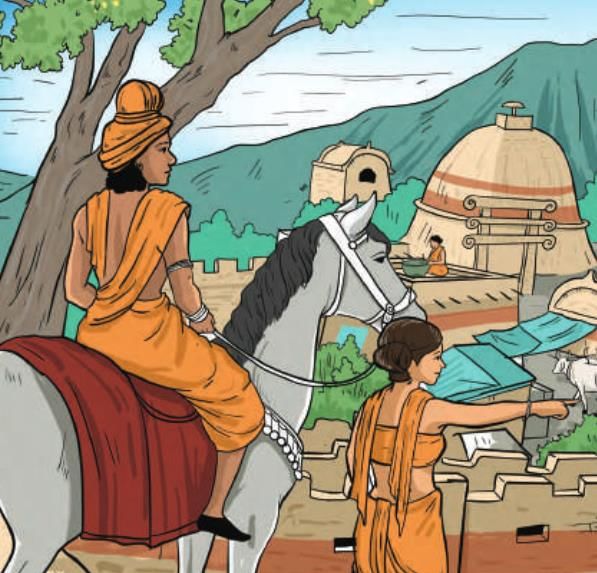 Representation of Pataliputra
Representation of Pataliputra
- Cities like Pataliputra became thriving centers of trade, culture, and politics.
- These cities were well-fortified with walls, moats, and drawbridges to protect their people from enemies.
- Life in these cities was lively, with markets full of goods from faraway places and entertainers like acrobats and musicians bringing joy to the streets.
What is an Empire?
An empire is a large area where a powerful ruler, called an emperor, controls many smaller kingdoms or territories. The word “empire” comes from the Latin word imperium, meaning “supreme power.”
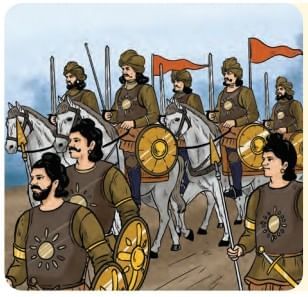 Smaller kingdoms act as tributaries, paying tribute (money, gold, grain, livestock, etc.) to the emperor as a sign of loyalty.
Smaller kingdoms act as tributaries, paying tribute (money, gold, grain, livestock, etc.) to the emperor as a sign of loyalty.
Sanskrit Terms for Emperor:
- Samraj: Lord of all or supreme ruler.
- Adhiraja: Overlord.
- Rajadhiraja: King of kings.
Features of an Empire
- Empires were large, covering many regions with diverse people, languages, and customs.
- Emperors used warfare to conquer smaller kingdoms and expand their empire.
- They built fortified cities with moats and drawbridges for defense, especially at borders.
- Emperors controlled rivers and trade routes to gain resources and tax money.
- Trained armies with elephants, horses, and iron weapons were used to conquer, defend, and maintain control.
- Emperors allowed local rulers to govern their areas in return for tribute and loyalty.
- Emperors ensured harmony by managing diverse groups, possibly through fair laws, local governance, or cultural exchanges.
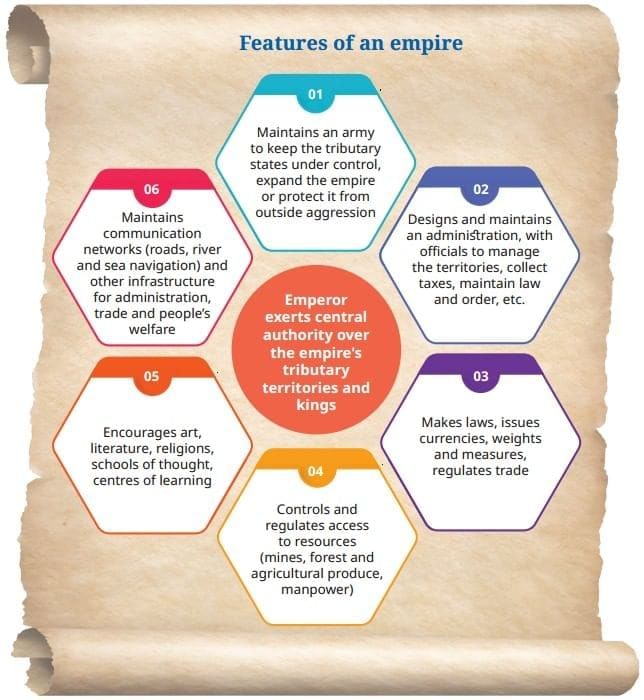
- Desire for fame and to be remembered by future generations (posterity).
- Access to resources for economic and military strength.
- Wealth for the emperor and the empire.Question for Chapter Notes: The Rise of EmpiresTry yourself:What is an empire?View Solution
Trade, Trade Routes, and Guilds
Trade was key to an empire’s wealth and people’s well-being. Maintaining an army was costly (food, weapons, horses, roads, ships), requiring strong economic power.
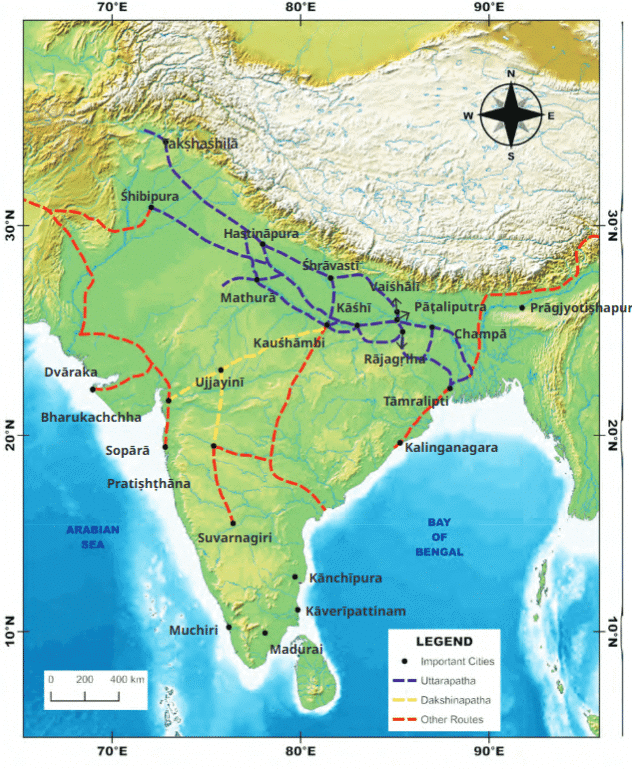 Trade Routes
Trade Routes
- Controlling trade routes increased the variety and amount of goods traded, boosting income and taxes.
- Traded goods included textiles, spices, gems, handicrafts, agricultural produce, and animals, sent to distant countries by land or sea.
- Guilds (shrenis) were groups of traders, craftsmen, moneylenders, or farmers who worked together.
- Guilds had a leader (often elected) and officers with good qualities, making rules for their members.
- Important trade routes were Uttarapatha (northwest to east) and Dakṣhiṇapatha (central to south India).
- Guilds spread across India and influenced trade for centuries, showing how Indian society organized itself.
The Rise of Magadha
From the 6th to 4th century BCE, Magadha (modern south Bihar) became a powerful kingdom in north India. Magadha was one of the 16 mahajanapadas, large kingdoms with assemblies.
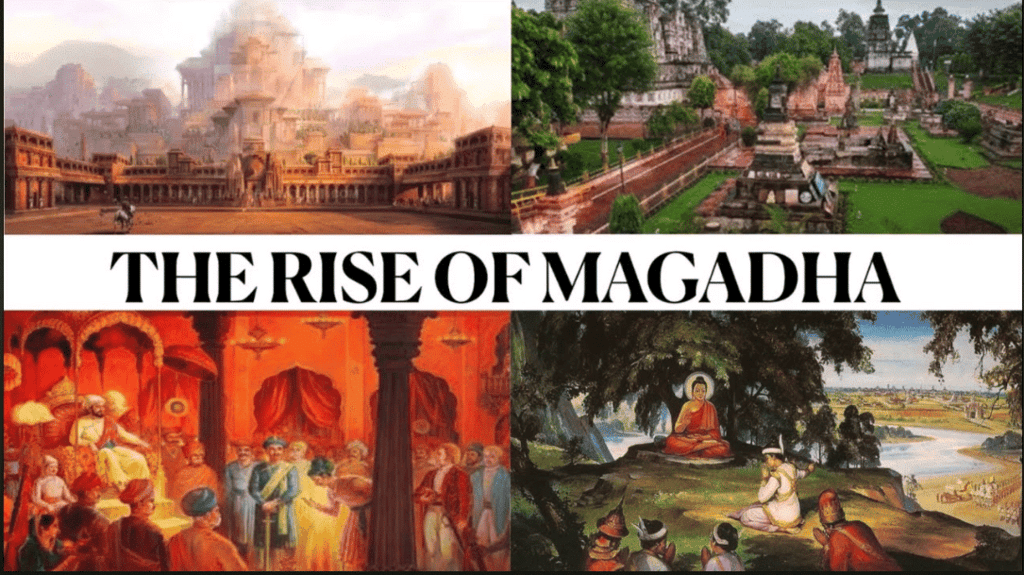
- Kings like Ajatashatru made Magadha a strong center of power.
- Magadha’s advantages:
- Fertile land in the Ganga plains for farming.
- Forests for timber and elephants for the army.
- Iron ore from nearby hills for tools and weapons.
- Ganga and Son rivers for trade and transport.
- Iron ploughs increased food production, and iron weapons strengthened the army.
- Surplus food allowed people to focus on arts and crafts, traded within and outside Magadha.
- In the 5th century BCE, Mahapadma Nanda founded the Nanda dynasty, uniting many kingdoms in eastern and northern India.
- The Nandas issued coins and had a large army, showing their wealth and power.
- The last Nanda emperor, Dhana Nanda, was unpopular for oppressing people, leading to the Nanda empire’s fall to the Maurya Empire.
The Arrival of the Greeks
In the northwest, small kingdoms existed along an ancient route to the Mediterranean. Alexander, a Greek king, invaded India in 327–325 BCE, aiming to rule the world.
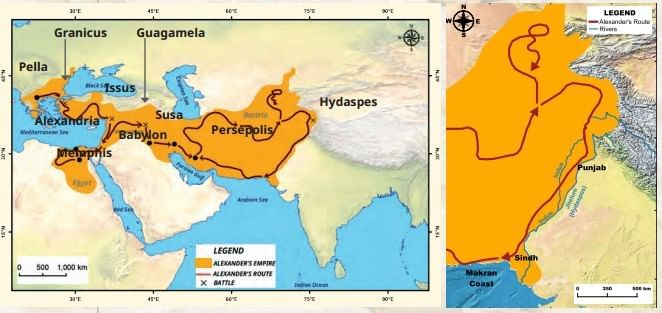 Arrival of Greeks
Arrival of Greeks
- He defeated Porus, king of the Pauravas in Punjab, but faced strong resistance from local tribes.
- Greek records note that women fought alongside men in some battles.
- Alexander was wounded, and his tired soldiers refused to march to the Ganga River, so he retreated through harsh southern deserts, losing many troops.
- Alexander left satraps (governors) to manage northwest territories, who had significant power.
- In 323 BCE, Alexander died in Babylon, and his empire split among his generals and satraps.
- Alexander met Gymnosophists (Indian sages called “naked philosophers” by Greeks) and asked them riddles, impressed by their wise answers.
- This meeting showed a blend of Greek and Indian philosophies.
The Mighty Mauryas
Around 321 BCE, Chandragupta Maurya founded the Maurya Empire in Magadha, taking over the Nanda empire. With help from his mentor Kautilya, Chandragupta expanded the empire from northern plains to the Deccan plateau.
- He defeated Greek satraps in the northwest, uniting those areas into the empire.
- Chandragupta welcomed Megasthenes, a Greek historian, who wrote about India in his book Indika (now mostly lost).
- The Mauryas built a strong empire with lasting impacts on trade, cities, administration, art, and architecture.
The Story of Kautilya
- Kautilya (also called Chanakya or Vishnugupta) was a teacher at Takṣhaśhila university.
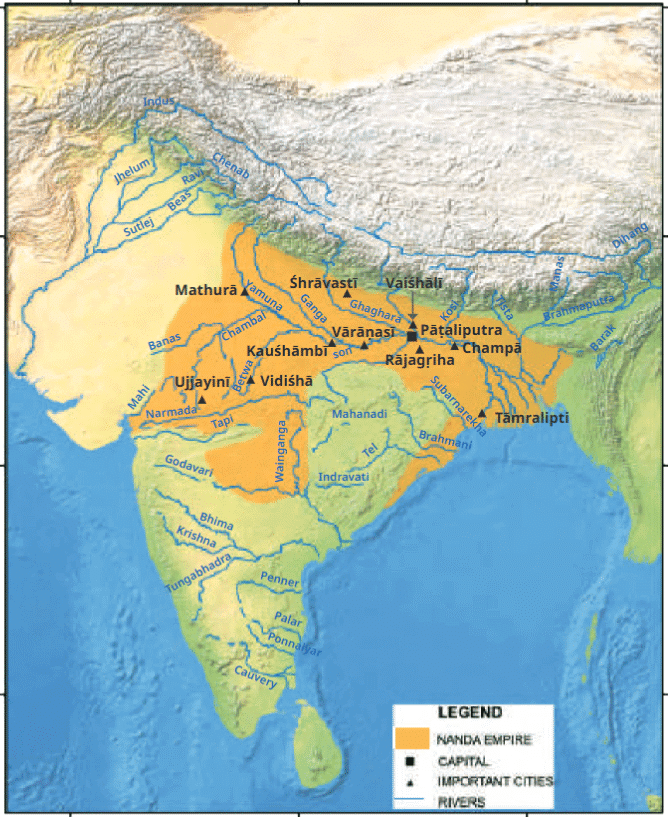 Maurya Empire
Maurya Empire - He advised Dhana Nanda to rule better, but was insulted and expelled from the Nanda court.
- Kautilya vowed to end the Nanda rule and helped Chandragupta Maurya overthrow the Nandas.
- His knowledge of politics, governance, and economics shaped the Maurya Empire.
The Rise of Chandragupta Maurya
- Chandragupta Maurya overthrew the Nandas and became ruler of Magadha, with Paṭaliputra as his capital.
- Magadha’s fertile land, trade routes, and economic system helped him expand the empire.
- With Kautilya’s strategies, Chandragupta defeated Greek satraps and extended his rule across northern and central India.
- He kept friendly ties with Greeks, hosting Megasthenes in his court.
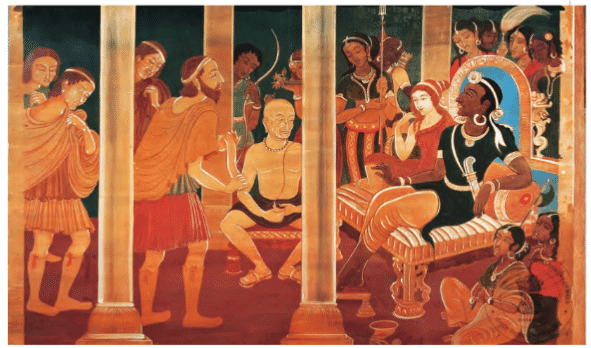 Megasthenes in the court of Chandragupta Maurya
Megasthenes in the court of Chandragupta Maurya
Kautilya’s Concept of a Kingdom
- Kautilya wrote the Arthashastra, a book on governance, economics, defense, and administration.
- He believed a kingdom should be strong, protected, and prosperous, achieved through warfare or alliances.
- Kautilya stressed law and order, with strict laws against corruption and punishments for harming people.
- He said a king’s happiness depends on his people’s welfare, prioritizing their interests over his own.
- Kautilya valued the countryside, as it was the source of food and economic activity, encouraging projects like bridges and village protection.
Kautilya’s Saptanga
Saptanga means “seven parts” of a kingdom. These seven parts worked together to make a kingdom stable and prosperous.
As per Kautilya:
- King (swami): The ruler who leads the kingdom.
- Amatya: Group of councillors
- Territory and people (janapada): The land and its population.
- Fortified cities (durga): Strong towns for defense.
- Treasury (koṣha): The kingdom’s wealth.
- Army and law enforcement (danda): Forces for defense and order.
- Allies (mitra): Friendly kingdoms for support.
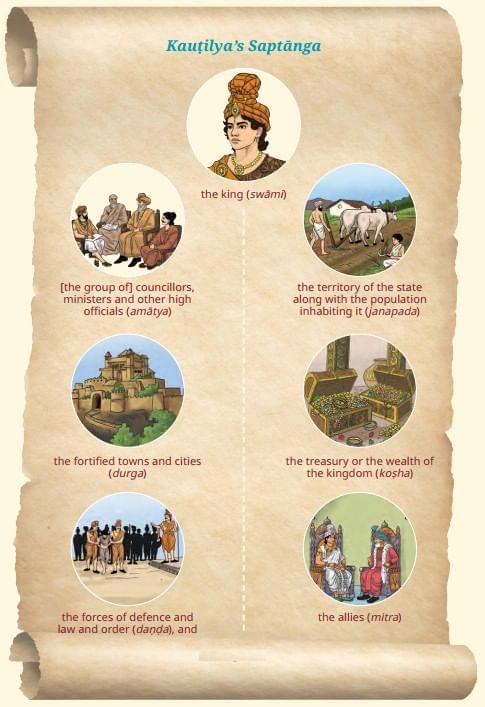
The King Who Chose Peace
Ashoka (268–232 BCE), Chandragupta’s grandson, ruled the Maurya Empire. He expanded the empire to cover most of India, except the far south, including Bangladesh, Pakistan, and parts of Afghanistan.
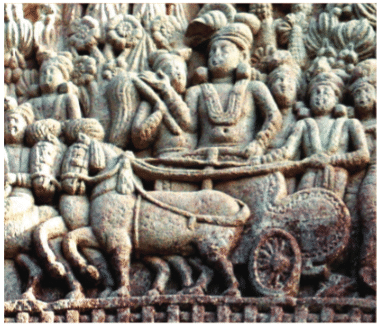 Figure of Ashoka at Sanchi Stupa
Figure of Ashoka at Sanchi Stupa
- During the Kalinga war (modern Odisha), Ashoka saw massive destruction and chose peace and non-violence, inspired by Buddhist teachings.
- Ashoka shared the Kalinga war in his edicts, showing honesty about his past.
- He sent messengers to Sri Lanka, Thailand, and Central Asia to spread Buddhism.
- Ashoka’s edicts, written in Prakrit using Brahmi script, were carved on rocks and pillars, urging people to follow dharma (moral duties).
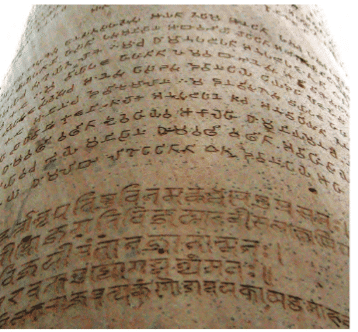 Ashoka Stone Edicts
Ashoka Stone Edicts - He called himself Devanampiya Piyadasi (“Beloved of the Gods, one who is kind”).
- Ashoka supported all sects (Buddhists, Jains, Brahmins, ajīvikas), provided medical care for people and animals, banned hunting, and planted trees and rest houses along roads.
- His edicts ensured officials were fair, avoided torture, and checked on people’s welfare every five years.
Life in the Mauryan Period
Cities like Pataliputra were centers of governance and trade, with palaces, public buildings, and planned streets. A strong tax system and active trade kept the treasury full, supporting growth.
- Officials, merchants, and artisans were key to city life.
- The Sohgaura copper plate (4th–3rd century BCE) shows the Mauryas built granaries to store grain against famines.
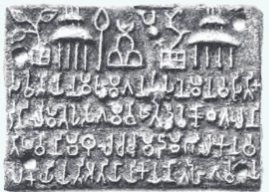 Sohgaura Copper Plate Inscription
Sohgaura Copper Plate Inscription
- Agriculture was vital, with two crops yearly due to summer and winter rains, preventing famines.
- Farmers were protected during wars, ensuring food production.
- City artisans included blacksmiths, potters, carpenters, and jewellers.
- Cities had street signs, couriers for messages, and wooden houses up to two storeys tall.
- Water vessels were kept on streets to fight fires.
- People wore cotton clothes (lower garment to the knees, upper garment over shoulders) and leather shoes with designs.
Some Contributions of the Mauryas
- The Mauryas left a lasting legacy in art, architecture, and governance.
- They strengthened trade routes, used coins widely, and built well-planned cities.
- Their administration system was advanced, with officials ensuring fairness and welfare.
Life and People
Mauryan society included farmers, artisans, merchants, and performers like street acrobats who entertained with plays and dances. Artefacts show people’s lives: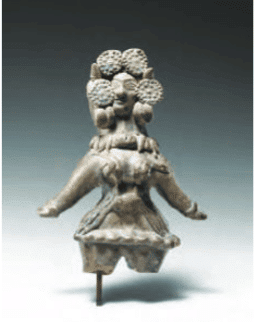 Terracotta Figurine of Female Deity
Terracotta Figurine of Female Deity
- Terracotta figurines of dancing girls and deities with elaborate headdresses and jewellery.
- Figurines of the Saptamatrikas (seven mother goddesses), a tradition still followed.
- A terracotta horse head with a designed bridle, showing skilled craftsmanship.
Art and Architecture
- Mauryan art and architecture were highly advanced.
- Sarnath pillar capital: Four lions (symbolizing royal power) and a dharmachakra (wheel of dharma) became India’s national emblem with the motto satyameva jayate (“truth alone triumphs”).
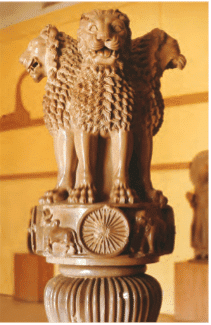 Four Lions
Four Lions - Sanchi Stūpa: One of India’s oldest stone structures, originally brick, enlarged with stone, built by Ashoka for worship.
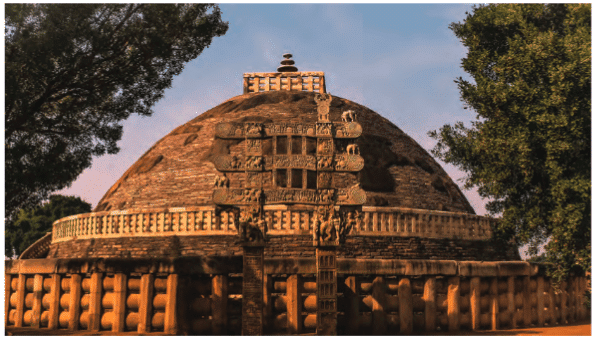 Sanchi Stupa
Sanchi Stupa - Dhauli elephant sculpture: A rock carving symbolizing the Buddha’s qualities, near an Ashoka edict.
- Mauryas built stūpas, chaityas, and viharas for worship, study, and meditation.
The Fragile Nature of Empires
While empires could unite vast territories and bring prosperity, they were also fragile and difficult to control. Several factors made them unstable:
- Over-extension: The larger the empire, the harder it was to govern. Distant regions often broke away first, as seen after Ashoka’s reign.
- Weak successors: Strong emperors like Chandragupta or Ashoka held power firmly, but weaker rulers who followed struggled to maintain authority.
- Heavy demands on resources: Long wars, droughts, or famines forced emperors to increase taxes or demand more tribute, creating resentment among local rulers.
- Local independence: Tributary kings sometimes stopped paying tribute when they sensed the central power weakening.
- Economic crises: Natural disasters like floods or droughts could reduce revenue and destabilize the empire.
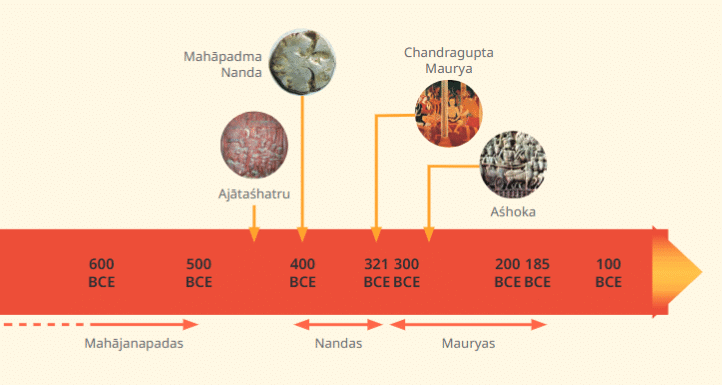 Timeline of Empires
Timeline of Empires
Points to Remember
- An empire is a large area of smaller kingdoms ruled by an emperor, expanded for fame, power, and resources.
- India’s first empires grew in areas with natural resources, rivers, and trade goods.
- Alexander’s campaign in northwest India had little political impact but started Indo-Greek cultural contacts.
- The Mauryas built a vast empire with lasting impacts on trade, cities, administration, art, and architecture.
- Ashoka promoted dharma and showed himself as a kind ruler through his edicts.
Difficult Words
- Empire: A large area of smaller kingdoms ruled by an emperor.
- Tributary: A kingdom that pays tribute to an emperor as a sign of loyalty.
- Guild: A group of traders or craftsmen who work together and make their own rules.
- Satrap: A governor of a province in Greek or Persian empires.
- Edict: An official order or announcement by a king.
- Dharma: Moral duties, truth, and living in harmony with the universe.
- Prakrit: A common language in ancient India, used in Ashoka’s edicts.
- Brahmi: An ancient script, the root of many Indian scripts.
- Saptanga: Kautilya’s seven parts of a kingdom (king, territory, cities, treasury, army, allies).
- Arthashastra: Kautilya’s book on governance and economics.
- Dharmachakra: Wheel of dharma, symbolizing Buddha’s teachings.
- Stūpa: A dome-shaped structure housing sacred relics, used for worship.
FAQs on The Rise of Empires Class 7 Notes Social Science Chapter 5 Free PDF
| 1. What are the main features of an empire? |  |
| 2. How did trade and trade routes contribute to the rise of empires? |  |
| 3. Who was Kauṭilya and what was his significance in the context of the Mauryan Empire? |  |
| 4. What was the impact of the arrival of the Greeks on the Indian subcontinent? |  |
| 5. How did Chandragupta Maurya rise to power and what strategies did he use? |  |






















